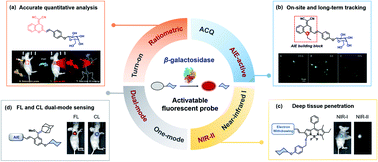Enzyme-activatable fluorescent probes for β-galactosidase: from design to biological applications
Abstract
β-Galactosidase (β-gal), a typical hydrolytic enzyme, is a vital biomarker for cell senescence and primary ovarian cancers. Developing precise and rapid methods to monitor β-gal activity is crucial for early cancer diagnoses and biological research. Over the past decade, activatable optical probes have become a powerful tool for real-time tracking and in vivo visualization with high sensitivity and specificity. In this review, we summarize the latest advances in the design of β-gal-activatable probes via spectral characteristics and responsiveness regulation for biological applications, and particularly focus on the molecular design strategy from turn-on mode to ratiometric mode, from aggregation-caused quenching (ACQ) probes to aggregation-induced emission (AIE)-active probes, from near-infrared-I (NIR-I) imaging to NIR-II imaging, and from one-mode to dual-mode of chemo-fluoro-luminescence sensing β-gal activity.

- This article is part of the themed collection: Most popular 2021 analytical chemistry articles, 2021


 Please wait while we load your content...
Please wait while we load your content...